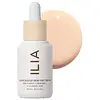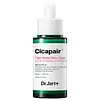Ilia Super Serum Skin Tint SPF 40 Versus Dr. Jart+ Cicapair Tiger Grass Camo Drops Color Corrector SPF 35
What's inside
What's inside
 Key Ingredients
Key Ingredients

 Benefits
Benefits

 Concerns
Concerns

 Ingredients Side-by-side
Ingredients Side-by-side

Zinc Oxide 12%
Cosmetic ColorantWater
Skin ConditioningSqualane
EmollientShea Butter Ethyl Esters
EmollientIsoamyl Laurate
EmollientPolyglyceryl-3 Ricinoleate
EmulsifyingButyloctyl Salicylate
Skin ConditioningPropanediol
SolventIsopropyl Isostearate
EmollientPolyglyceryl-3 Diisostearate
EmulsifyingMethylpropanediol
SolventNiacinamide
SmoothingSodium Chloride
MaskingLecithin
EmollientCaprylyl Glycol
EmollientSilica
AbrasiveAloe Barbadensis Leaf Juice Powder
Skin ConditioningBisabolol
MaskingHydrolyzed Sodium Hyaluronate
Skin ConditioningAllantoin
Skin ConditioningPhenylpropanol
MaskingSodium Myristoyl Glutamate
CleansingSodium Hyaluronate
HumectantTetrasodium Glutamate Diacetate
Aluminum Hydroxide
EmollientPolyhydroxystearic Acid
EmulsifyingCI 77491
Cosmetic ColorantCI 77492
Cosmetic ColorantCI 77499
Cosmetic ColorantTitanium Dioxide
Cosmetic ColorantZinc Oxide 12%, Water, Squalane, Shea Butter Ethyl Esters, Isoamyl Laurate, Polyglyceryl-3 Ricinoleate, Butyloctyl Salicylate, Propanediol, Isopropyl Isostearate, Polyglyceryl-3 Diisostearate, Methylpropanediol, Niacinamide, Sodium Chloride, Lecithin, Caprylyl Glycol, Silica, Aloe Barbadensis Leaf Juice Powder, Bisabolol, Hydrolyzed Sodium Hyaluronate, Allantoin, Phenylpropanol, Sodium Myristoyl Glutamate, Sodium Hyaluronate, Tetrasodium Glutamate Diacetate, Aluminum Hydroxide, Polyhydroxystearic Acid, CI 77491, CI 77492, CI 77499, Titanium Dioxide
Water
Skin ConditioningCyclopentasiloxane
EmollientIsononyl Isononanoate
EmollientPentaerythrityl Tetraisostearate
EmollientButyloctyl Salicylate
Skin ConditioningMethyl Trimethicone
Skin ConditioningIsododecane
EmollientDipropylene Glycol
HumectantDiphenylsiloxy Phenyl Trimethicone
Skin ConditioningLauryl PEG-10 Tris(Trimethylsiloxy)Silylethyl Dimethicone
EmulsifyingMethyl Methacrylate Crosspolymer
Acrylates/Dimethicone Copolymer
Skin ConditioningNiacinamide
SmoothingPolymethylsilsesquioxane
Disteardimonium Hectorite
StabilisingPolyglyceryl-4 Isostearate
EmulsifyingMagnesium Sulfate
Dipentaerythrityl Hexahydroxystearate/Hexastearate/Hexarosinate
Skin ConditioningBeeswax
Emulsion Stabilising1,2-Hexanediol
Skin ConditioningTriethoxycaprylylsilane
Centella Asiatica Extract
CleansingCaprylyl Glycol
EmollientSynthetic Fluorphlogopite
Glyceryl Caprylate
EmollientZein
Skin ConditioningEthylhexylglycerin
Skin ConditioningSilica Dimethyl Silylate
EmollientAluminum Hydroxide
EmollientAdenosine
Skin ConditioningLavandula Angustifolia Oil
MaskingZea Mays Starch
AbsorbentCitrus Paradisi Peel Oil
MaskingHydrogenated Lecithin
EmulsifyingRosmarinus Officinalis Leaf Oil
MaskingCaprylic/Capric Triglyceride
MaskingHelianthus Annuus Seed Oil
EmollientSodium Chloride
MaskingDipotassium Phosphate
BufferingCalcium Stearate
Cosmetic ColorantGossypium Herbaceum Seed Oil
Skin ConditioningAnthemis Nobilis Flower Oil
MaskingPanthenol
Skin ConditioningButylene Glycol
HumectantAnastatica Hierochuntica Extract
AstringentHouttuynia Cordata Extract
Skin ConditioningAniba Rosaeodora Wood Oil
AstringentCitral
PerfumingPentylene Glycol
Skin ConditioningZinc Gluconate
Skin ConditioningMagnesium Aspartate
Skin ConditioningLecithin
EmollientGlycerin
HumectantBrassica Campestris Sterols
EmollientAlcohol
AntimicrobialSucrose Laurate
EmollientPolyglyceryl-2 Caprate
EmulsifyingLeuconostoc/Radish Root Ferment Filtrate
AntimicrobialArnica Montana Flower Extract
MaskingCentella Asiatica Leaf Extract
Skin ConditioningFragaria Vesca Fruit Extract
AstringentCopper Gluconate
Skin ConditioningLysolecithin
EmulsifyingCeramide NP
Skin ConditioningLimonene
PerfumingLinalool
PerfumingCaprylhydroxamic Acid
Madecassoside
AntioxidantTocopherol
AntioxidantSodium Ascorbyl Phosphate
AntioxidantPhenoxyethanol
PreservativeCI 77891
Cosmetic ColorantCI 77491
Cosmetic ColorantCI 77492
Cosmetic ColorantCI 77288
Cosmetic ColorantWater, Cyclopentasiloxane, Isononyl Isononanoate, Pentaerythrityl Tetraisostearate, Butyloctyl Salicylate, Methyl Trimethicone, Isododecane, Dipropylene Glycol, Diphenylsiloxy Phenyl Trimethicone, Lauryl PEG-10 Tris(Trimethylsiloxy)Silylethyl Dimethicone, Methyl Methacrylate Crosspolymer, Acrylates/Dimethicone Copolymer, Niacinamide, Polymethylsilsesquioxane, Disteardimonium Hectorite, Polyglyceryl-4 Isostearate, Magnesium Sulfate, Dipentaerythrityl Hexahydroxystearate/Hexastearate/Hexarosinate, Beeswax, 1,2-Hexanediol, Triethoxycaprylylsilane, Centella Asiatica Extract, Caprylyl Glycol, Synthetic Fluorphlogopite, Glyceryl Caprylate, Zein, Ethylhexylglycerin, Silica Dimethyl Silylate, Aluminum Hydroxide, Adenosine, Lavandula Angustifolia Oil, Zea Mays Starch, Citrus Paradisi Peel Oil, Hydrogenated Lecithin, Rosmarinus Officinalis Leaf Oil, Caprylic/Capric Triglyceride, Helianthus Annuus Seed Oil, Sodium Chloride, Dipotassium Phosphate, Calcium Stearate, Gossypium Herbaceum Seed Oil, Anthemis Nobilis Flower Oil, Panthenol, Butylene Glycol, Anastatica Hierochuntica Extract, Houttuynia Cordata Extract, Aniba Rosaeodora Wood Oil, Citral, Pentylene Glycol, Zinc Gluconate, Magnesium Aspartate, Lecithin, Glycerin, Brassica Campestris Sterols, Alcohol, Sucrose Laurate, Polyglyceryl-2 Caprate, Leuconostoc/Radish Root Ferment Filtrate, Arnica Montana Flower Extract, Centella Asiatica Leaf Extract, Fragaria Vesca Fruit Extract, Copper Gluconate, Lysolecithin, Ceramide NP, Limonene, Linalool, Caprylhydroxamic Acid, Madecassoside, Tocopherol, Sodium Ascorbyl Phosphate, Phenoxyethanol, CI 77891, CI 77491, CI 77492, CI 77288
 Reviews
Reviews

Ingredients Explained
These ingredients are found in both products.
Ingredients higher up in an ingredient list are typically present in a larger amount.
Aluminum Hydroxide is a form of aluminum. It can be naturally found in nature as the mineral gibbsite. In cosmetics, Aluminum Hydroxide is used as a colorant, pH adjuster, and absorbent.
As a colorant, Aluminum Hydroxide may add opacity, or reduce the transparency. Aluminum hydroxide is contains both basic and acidic properties.
According to manufacturers, this ingredient is an emollient and humectant. This means it helps hydrate the skin.
In medicine, this ingredient is used to help relieve heartburn and help heal ulcers.
There is currently no credible scientific evidence linking aluminum hydroxide in cosmetics to increased cancer risk.
Major health organizations allow the use of aluminum hydroxide in personal care products and have not flagged it as a carcinogenic risk at typical usage levels.
Learn more about Aluminum HydroxideButyloctyl Salicylate is a chemical UV filter structurally similar to octisalate. It is a photostabilizer, SPF booster, emollient and solvent. This ingredient helps evenly spread out ingredients.
According to a manufacturer, it is suitable for pairing with micro Titanium Dioxide, Zinc Oxide, and pigments.
Photostabilizers help stabilize UV-filters and prevents them from degrading quickly.
Learn more about Butyloctyl SalicylateCaprylyl Glycol is a humectant and emollient, meaning it attracts and preserves moisture.
It is a common ingredient in many products, especially those designed to hydrate skin. The primary benefits are retaining moisture, skin softening, and promoting a healthy skin barrier.
Though Caprylyl Glycol is an alcohol derived from fatty acids, it is not the kind that can dry out skin.
This ingredient is also used as a preservative to extend the life of products. It has slight antimicrobial properties.
Learn more about Caprylyl GlycolCi 77491 is also hydrated iron III oxide. It's sole purpose is to give a red/pink hue to products.
Iron III oxides are classified as inorganic chemicals for coloring.
Synthetically created Ci 77491 is considered safer than those naturally found. This is because the synthetically created version may contain less impurities. Iron oxides are generally non-toxic and non-allergenic.
Learn more about CI 77491Ci 77492 is also hydrated iron III oxide. It's sole purpose is to give a yellow hue to products.
Iron III oxides are classified as inorganic chemicals for coloring.
Synthetically created Ci 77492 is considered safer than those naturally found. This is because the synthetically created version may contain less impurities. Iron oxides are generally non-toxic and non-allergenic.
Learn more about CI 77492Lecithin is a term for a group of substances found in the cell membranes of plants, animals, and humans. They are made up of mixture of phospholipids.
This ingredient has emollient and emulsifying properties.
As an emollient, lecithen helps soften the skin and creates a barrier to keep moisture in.
As an emulsifier, it also helps prevent water and oil ingredients from separating. Lecithin can also help ingredients be better absorbed by the skin.
This is because the phospholipids in lecithin produce liposomes. Liposomes help other ingredients get through the skin barrier.
Depending on the source of this ingredient, lecithin may not be fungal acne safe. This is because some sources of lecithin come from soybean oil, which may feed the malassezia yeast that feeds fungal acne.
We recommend reaching out to the brand you are purchasing from to inquire about the source of their lecithin.
Some other names for this ingredient include soy lecithin and deoiled soy lecithin.
Learn more about LecithinNiacinamide is a multitasking form of vitamin B3 that strengthens the skin barrier, reduces pores and dark spots, regulates oil, and improves signs of aging.
And the best part? It's gentle and well-tolerated by most skin types, including sensitive and reactive skin.
You might have heard of "niacin flush", or the reddening of skin that causes itchiness. Niacinamide has not been found to cause this.
In very rare cases, some individuals may not be able to tolerate niacinamide at all or experience an allergic reaction to it.
If you are experiencing flaking, irritation, and dryness with this ingredient, be sure to double check all your products as this ingredient can be found in all categories of skincare.
When incorporating niacinamide into your routine, look out for concentration amounts. Typically, 5% niacinamide provides benefits such as fading dark spots. However, if you have sensitive skin, it is better to begin with a smaller concentration.
When you apply niacinamide to your skin, your body converts it into nicotinamide adenine dinucleotide (NAD). NAD is an essential coenzyme that is already found in your cells as "fuel" and powers countless biological processes.
In your skin, NAD helps repair cell damage, produce new healthy cells, support collagen production, strengthen the skin barrier, and fight environmental stressors (like UV and pollution).
Our natural NAD levels start to decline with age, leading to slower skin repair, visible aging, and a weaker skin barrier. By providing your skin niacinamide, you're recharging your skin's NAD levels. This leads to stronger, healthier, and younger looking skin.
Another name for vitamin B3 is nicotinamide. This vitamin is water-soluble and our bodies don't store it. We obtain Vitamin B3 from either food or skincare. Meat, fish, wheat, yeast, and leafy greens contain vitamin B3.
The type of niacinamide used in skincare is synthetically created.
Learn more about NiacinamideChances are, you eat sodium chloride every day. Sodium Chloride is also known as table salt.
This ingredient has many purposes in skincare: thickener, emulsifier, and exfoliator.
You'll most likely find this ingredient in cleansers where it is used to create a gel-like texture. As an emulsifier, it also prevents ingredients from separating.
There is much debate on whether this ingredient is comedogenic. The short answer - comedogenic ratings don't tell the whole story. Learn more about comegodenic ratings here.
The concensus about this ingredient causing acne seems to be divided. Research is needed to understand if this ingredient does cause acne.
Scrubs may use salt as the primary exfoliating ingredient.
Learn more about Sodium ChlorideWater. It's the most common cosmetic ingredient of all. You'll usually see it at the top of ingredient lists, meaning that it makes up the largest part of the product.
So why is it so popular? Water most often acts as a solvent - this means that it helps dissolve other ingredients into the formulation.
You'll also recognize water as that liquid we all need to stay alive. If you see this, drink a glass of water. Stay hydrated!
Learn more about Water